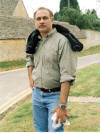|
|
the-south-asian.com July / August 2006 |
|
|||
|
August/September Contents
Sufis - wisdom against 50
years of mountain Heritage cities:
Cotton - the fibre of
|
|
||||
|
Page
6 of 6
Harappan Heritage by Salman Minhas
First published June 2005
Culture, Technology, Trade: Aryans & Indus Valley - Urbanized or Rural ? According to Professor Dani , the Aryans, based on literary records in the Rigveda, the earliest book or the first nine books of the Rigveda, do not speak at all of any urban life. They speak of only rural life, villages, and as the Indus Civilization is an urban civilization, Dani contends that to talk of any Aryan association with the urban life seems rather unthinkable. In the entire book of the Rigveda, it is totally rural life [ not nomadic], agricultural, living in small villages, that the Rigveda writes about. At the same time, the Aryans had no concept of irrigation, they had no use of dams on the rivers; in fact their god Indra is the destroyer of the dams. Hence the type of agriculture and the type of urban life the Indus Civilization people built up was beyond the conception of the Aryans or even the earlier Aryans. Whatever has been gathered from other Aryan languages, not just Sanskrit, from old Iranian, there is nothing of urbanity, nothing of irrigation, nothing called building the dams. All these three are basic factors in the development of the Indus Civilization. The Indus Vallety writing script—another puzzle ! Attempts to identify the language used in the IVC have led to 2 major theses being propounded on the language used in Harappa and MohenjoDaro. One group of scholars consisting of Asko Parpola [ Finland], I Mahadevan [ India and Prof. Dani [ Pakistan ] claim that the language is proto-Dravidian . In fact Brahui , a language spoken even today in nearby Baluchistan is Dravidian. The other group led by Rao and Krishna Rao claims it to be proto- Sanskrit. It is beyond the scope of this article to delve more into this subject. It is sufficient to note here that this subject requires more samples of writing before any conclusive result is obtained.
Decline & Fall of the Indus Valley Civilization. The decline & fall of the Indus civilization is one of the most enigmatic "whodunit" of the archaeological world. The old myth of the Aryan invasion of India riding on horses from central & west Asia propounded by the scholars such as Max Muller simply is not correct anymore. Only 37 skeletons were found in MohenjoDaro in all by Wheeler. The reverse may in fact be true – that Dravidians in the Indus valley civilization may in fact have traveled to Ur, Susa & Akkad in modern day Iraq to start the Mesopotamian culture. Reasons -- Geological Calamities : The earthquake of 1819 resulted in an area of 2000 square miles being submerged forming an inland sea near Thatta. The area resulted in an elevation known as Allah Bund [Mound /Embankment of God] which was 10-26 feet high, 20 miles wide and 50 miles long. In 1826, the Indus burst every dam in its course and carved a passage through old channels. MohenjoDaro itself lies in a zone that narrows into a bottle-neck of sediment which the entire Punjab drainage has to go through. Thus the vagrant nature of the Indus has shown itself manifesting in the form of bow lakes such as Manchar ,Haleji, etc . Finally the large glacial lakes in the northern areas of the Indus river that form accidentally by rock falls /landslides may also play a part in getting the Indus river to be blamed for its downstream floods . Government College University Forest Reserve at Harappa: Within and surrounding the Harappa site, are the remains of a forest of trees on various excavation mounds E, and ET . The Trees are estimated to be 200 to 500 years old and consist of Salvador Oleoides [leaves like pine Needle, local name is "Kuwan" or simply "Wan" ] . Capparis Decidua [ Local name "Karir"] and Tamarix aphylla [local name "Frash"] also dot the landscape at Harappa . The entire area has been taken over in 1994 by the Government College University, Lahore, Department of Botany. Dr. Amin Khan , Head of Botany Department and Ms.Fawzia Sharif , a Ph.d graduate student have pioneered these efforts and managed to preserve the area as a protected forest reserve. It appears that conservation in archaeology and in ecology & biological/botanical areas seems to converge in Harappa.
Other distinctive features of the IVC were : a unique and undeciphered written script; Distinctive animal and human figurine assemblage A Pottery unique in terms of manufacturing technique, decoration, shape, and style. Lastly a virtually complete lack of any military-related materials, both in terms of weapons and probably fortifications. Interestingly no palaces, forts, pyramids, temples or other types of power center architectural constructions. _____________
|
|||||
|
Copyright © 2000 - 2006 [the-south-asian.com]. Intellectual Property. All rights reserved. |
|||||

